Aridic Soils from Orders other than Aridisols
These are images of aridic soils classified in other Orders than the
Aridisols. The classification and text are from the 1975 edition of Soil Taxonomy and
the new classification is also shown.
|
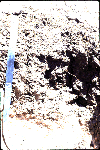
|
Mollic Torrerts (New classification: Petrocalcic Calcitorrerts):
These soils are like Typic Torrerts except that, after the surface
soil to a depth of 18 cm has been mixed, the color value, moist,
is closer to 3 than to 4 in more than half of each pedon, and the
dark color extends to a depth of 30 cm or more. They are mostly
soils that do not flood but have relatively higher precipitation
than Typic Torrerts. They are not extensive in the United States.
Most of them are used for grazing, and a few are irrigated.
|
|
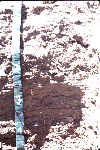
|
Typic Torriorthents (New classification: Typic Torriorthents (same)):
The typic subgroup is fixed on the driest Torriorthents that are
moderately deep or deep to hard rock. Soils that have weak cementation
by silica are excluded from the typic subgroup because that feature
is considered to indicate initial development of a duripan. The
Torriorthents that have clayey texture, cracks, and a swelling type
of clay are also excluded because they have so many similarities
to the Torrerts. No intergrades to Mollisols are recognized because
the Torriorthents are highly susceptible to erosion, and if any
have become stabilized enough by grasses to accumulate an appreciable
amount of organic matter, the slightest disturbance or use of the
vegetation is apt to initiate new erosion. The Typic Torriorthents
are extensive soils in the intermountain states of the United States.
Most of them have moderate to strong slopes and are used only for
grazing. Others that have gentle slopes are irrigated. The gently
sloping soils are mostly on fans or piedmont slopes where the sediments
are recent and had little organic carbon.
|
|

|
Torrertic Haplustolls (New classification: Torrertic Hoplustolls
(same)): These soils have clayey texture and deep wide cracks that
are open more than 6 months in most years. They formed in clayey
sediments, soft shales, or basic rocks, in association with Aridisols
and with aridic subgroups of Ustolls. Slopes of these soils in the
United States are gentle to moderate. A few of the soils are irrigated,
but most of them are used for grazing.
|
|
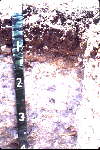
|
Ustollic Haplargids (New classification: Ustic Calciargids): Soils
in this subgroup have more organic matter than the soils of the
typic subgroup. Their moisture regime is marginal to an ustic regime.
They either have more summer precipitation than the typic soils
or they receive additional moisture as runoff from higher soils.
Most of them have an appreciable cover of perennial grasses. They
are extensive soils in the United States, particularly in the Great
Plains. Their slopes are mostly gentle. Some of these soils are
irrigated, and the others are used mostly for summer grazing.
|
|

|
Typic Torripsamments (New classification: Typic Torripsamments
(same)): The typic subgroup consists of the Torripsamments that
have little available moisture, do not have evident cementation
by silica, and have a moderately thick or thick regolith. The limitation
on moisture restricts the subgroup to the drier part of the range
of the great group. The restriction against a lithic contact is
the same one that is applied in typic subgroups throughout the taxonomy.
|
|

|
Petrocalcic Ustollic Paleargids (New classification: Argic Petrocalcids):
These soils have a petrocalcic horizon whose upper boundary is within
1 m of the soil surface, and they have more organic matter and more
moisture than Typic Paleargids. The moisture regime borders on ustic,
that is, the precipitation comes during a growing season when the
soil is warm. In addition, the upper boundary of the argillic horizon
is permitted to be clear or gradual. Slopes of these soils in the
United States are gentle. The soils are extensive locally in parts
of southwestern Texas. Most of them are used for summer grazing.
|
|
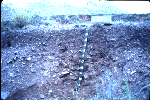
|
Pachic Haplustolls (New classification: Pachic Haplustolls (same)):
These soils have an overthickened epipedon and are permitted but
are not required to differ from Typic Haplustolls by having moderately
shallow ground water, mottles of low chroma, low color value and
chroma, and a deep calcic horizon. They are permitted to have a
cambic horizon. Most of these soils in the United States receive
runoff but little sediment from higher soils. Slopes of these soils
are gentle and mainly concave. The associated higher soils generally
have less available water. Most of the Pachic Haplustolls occur
in rather long and narrow areas, and they are cultivated if the
associated soils are cultivated.
|
|
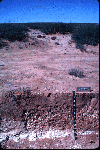
|
Typic Haplargids (New classification: Typic Calciargids): The central
concept of Haplargids, the typic subgroup, is fixed on soils that
do not have evidences of current ground water within a depth of
1 m, do not have appreciable cementation by silica, have little
organic matter or available moisture, and have little evidence of
soil movement. This concept reflects the driest part of the range
of moisture content in Haplargids. Soils that receive more moisture
have greater productivity for plants, more biologic activity, and
more soil organic matter. The Typic Haplargids do not have a lithic
contact within 50 cm of the surface. Many have a think epipedon
and argillic horizon and a ca horizon within 20 to 25 cm of the
surface. The Typic Haplargids are extensive soils in the western
states. Their slopes are mainly gentle. Most of them are used for
grazing.
|
|
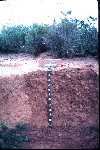
|
Typic Haplargids (New classification: Typic Haplargids (same)):
The central concept of Haplargids, the typic subgroup, is fixed
on soils that do not have evidences of current ground water within
a depth of 1 m, do not have appreciable cementation by silica, have
little organic matter or available moisture, and have little evidence
of soil movement. This concept reflects the driest part of the range
of moisture content in Haplargids. Soils that receive more moisture
have greater productivity for plants, more biologic activity, and
more soil organic matter. The Typic Haplargids do not have a lithic
contact within 50 cm of the surface. Many have a think epipedon
and argillic horizon and a ca horizon within 20 to 25 cm of the
surface. The Typic Haplargids are extensive soils in the western
states. Their slopes are mainly gentle. Most of them are used for
grazing.
|
|

|
Typic Camborthids (New classification: Typic Haplocambids): The
central concept or typic subgroup of Camborthids is fixed on soils
that have minimal horizon development for Aridisols. In general,
they are on the most recent deposits or erosion surfaces. They are
not permitted to have distinct horizons except that a calcic horizon
is permitted if the surface soil to a depth of 18 cm or more is
not sandy and does not have free carbonates. It is assumed that
a ca horizon is normal, but it may be absent if the parent materials
are acid and lime has not been added in dust. The normal horizon
sequence is therefore a desert pavement, a thin ochric epipedon
(2 to 5 cm), a cambic horizon, and a Bk horizon. The soils have
little organic matter or available water, and they represent the
drier part of the range of the great group. Soils that have more
moisture have greater biologic activity and more organic matter
and are considered intergrades to Mollisols. Weak silica cementation
indicates a transition to Durorthids. Clayey texture and swelling
clays indicate a transition to Vertisols. Typic Camborthids are
the driest but are not the most extensive subgroup of Camborthids
in the United States. They are widely scattered over the drier parts
of the southern Great Plains and the intermountain states. Their
slopes range from gentle to very strong. Most of these soils are
used for grazing, but where slopes are gentle and water is available,
many of them are irrigated.
|
|

|
Typic Calciorthids (New classification: Typic Haplocalcids): The
central concept of the typic subgroup of Calciorthids is fixed on
soils that show no effects of ground water within the upper 1 m,
do not have appreciable cementation by silica, have little organic
matter or available moisture, do not have shallow hard rock, and
do not have evidence of engulfment of a former argillic horizon
by the calcic horizon. Most of them are calcareous in all subhorizons,
but some loamy soils are noncalcareous in the upper few centimeters,
and some sandy soils are noncalcareous to a depth of about 25 cm.
The concept is one of soils that had or that are receiving more
carbonates than the small amount of rainfall can remove from the
surficial horizons. The calcic horizon commonly contains 40 percent
carbonates or more, particularly in calcareous parent materials,
but is not cemented into the continuous coherent sheet that constitutes
a petrocalcic horizon. It should be noted that the present limits
on organic-matter content are provisional. Calciorthids in a given
setting seem to have more organic matter than other adjacent Orthids,
but data are too few to propose another limit for this subgroup.
These soils are extensive in the arid regions of the United States.
Their slopes range from gentle to strong, and the soils either are
irrigated or are used for grazing.
|
|

